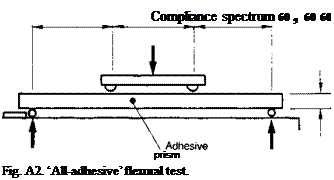Moisture resistance. The adhesive should be formulated to minimise moisture transport through the adhesive itself. The equilibrium water content (M„) should not exceed 3% by weight after immersion in distilled water at 20 °С. The permeability, obtained from the product of the coefficient of diffusion (D) and Mshould not exceed 5 x 10-14 m2/s at 20 °С (see Fig. A. l). A film of adhesive, approximately 1 mm thick cast in polytetrafluoroethylene-lined moulds and weighing at least 3 g, is suggested for this test(3). This requirement is to enhance the potential for a durable adhesive/adherend interface, even if moisture uptake is not deleterious to the adhesive itself.
|
(W*)i |
 |
Temperature resistance. The adhesive should have a heat distortion temperature (HDT) of at least 40 °С. A specimen 200 mm x 25 mm x 12 mm deep tested in four-point bending, as shown in Fig. A.2, is recommended(4). The sample under test is placed in a temperature-controlled cabinet at 20 °С and a load
Fig. Al. Fickian diffusion.
 |
applied such that the specimen is subjected to a maximum fibre stress of 1.81 MN m-2 in accordance with BS 2782 (5). The HDT of the adhesive is taken as the temperature attained, as measured on a thermocouple attached to the specimen, after undergoing a further 0.25 mm deflexion while subject to a surface heating rate of 0.5 °С per min. This requirement is primarily to enhance creep resistance.
Flexural modulus. The instantaneous flexural modulus of the adhesive at 20 °С should be at least 2000 MN m-2. A specimen 200 mm x 25 mm x 12 mm deep tested in four-point bending, as shown in Fig. A.2, is recommended(4). The sample under test is loaded at the third points at a rate of 1 mm/min and the central deflexion recorded. From the load-deflexion curve the secant modulus at 0.2% strain is calculated. This requirement is to assist in preventing problems due to creep of the adhesive under sustained loads. It should be noted that the higher the flexural modulus of the adhesive, the more susceptible the adhesive will be to stress concentrations arising from strain incompatibilities, for example at changes of section. For this reason, an upper limit of between 8000 and 10000 MN m-2 is probably desirable.
Shear strength. The bulk shear strength of the hardened adhesive at 20 °С should be at least 12 MN m-2. A specimen 200 mm x 12 mm x 25 mm deep tested in a shear box, as shown in Fig. A.3, is recommended(4). The complete assembly is loaded in compression through a spherical bearing at a rate of 1 mm/min. The failure load is taken as that load at which shear cracking first
occurs. This requirement ensures that the adhesive will be at least as strong as the concrete to which it is to be bonded.
Tensile strength. The tensile strength of the hardened adhesive at 20 °С should be at least 12 MN m-2. A dumb-bell specimen of dimensions according to BS 2782 : Part 3 (5) (methods 320 B/C) and having a cross-section of 10 mm x 3 mm is recommended (see Fig. A.4) (3). The specimens should be cast in polytetrafluoroethyl — ene-lined moulds. Adhesive ductility may also be measured with appropriate strain monitoring equipment.
 7 октября, 2015
7 октября, 2015  Malyar
Malyar  Опубликовано в рубрике
Опубликовано в рубрике 